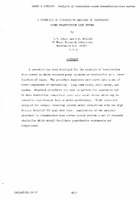| dc.contributor.author | Adams, B. B. | |
| dc.contributor.author | Giellis, G. R. | |
| dc.date.accessioned | 2018-10-11T14:04:53Z | |
| dc.date.available | 2018-10-11T14:04:53Z | |
| dc.date.issued | 1975/10 | |
| dc.identifier | 342 | |
| dc.identifier.govdoc | CP-17/8 | |
| dc.identifier.uri | http://hdl.handle.net/20.500.12489/28 | |
| dc.description.abstract | A procedure has been developed for the analysis of transmission loss curves in which received power is known or expressible as a linear function of range. The procedure separates each curve into a sum of three components of variability: long term trend, oscillatory, and random. Standard procedures are used to perform the separation and to make statistical comparison tests with other curves which may be companion experimental data or model predictions. Eight cases are analysed for example involving several model predictions with two high density detailed 300 n.mi shot runs. Application of the analysis procedure to transmission loss curves should provide a set of standard statistics which should facilitate quantitative statements and comparisons. | |
| dc.format | 33 p. : ill. ; digital, PDF file | |
| dc.language | English | |
| dc.publisher | NATO. SACLANTCEN | |
| dc.source | In: Ocean Acoustic Modelling (SACLANTCEN Conference Proceedings CP-17), Part 8, 1975, pp. 42-1 - 42-33. | |
| dc.subject | Acoustic propagation | |
| dc.subject | Transmission loss | |
| dc.subject | Acoustic models | |
| dc.title | A technique of comparative analysis of underwater sound transmission loss curves | |
| dc.type | Papers and Articles | |
| dc.type | Conference Proceedings (CP) | |
